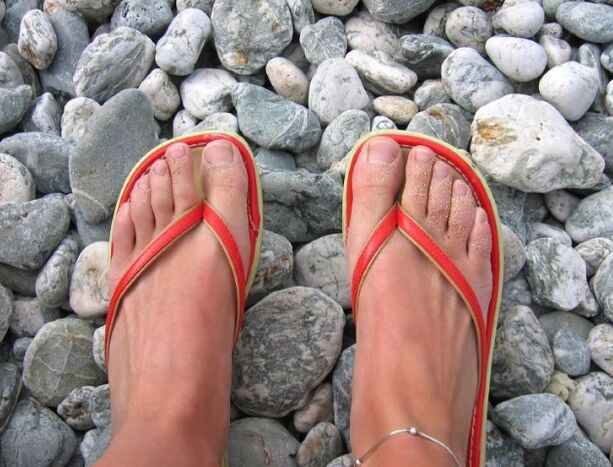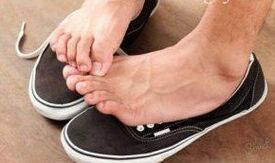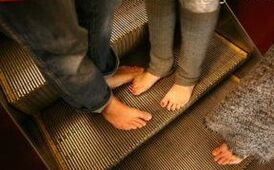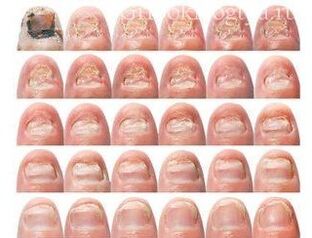Nail fungus is a fairly dangerous phenomenon that can develop and destroys the entire nail plate. In the early stages of development, the mushroom can be invisible to the eye, but its negative effect on the structure of the nail plate is reinforced every day. How to identify nail fungus yourself and how to treat it will continue to analyze in view of the stage of the disease.

There are a number of characters that help to determine the presence of mushroom lesions of the nail plate:
- The loosening of the nail - you can check if you cut the edge of the nail. If the nail is not cut, this is the first symptom for the presence of a mushroom and a clear opportunity to see a doctor.
- The thickening of the nail plate, mainly on edge hyperkeratosis (compression), occurs due to the harmful effects of mushrooms that can interfere with the integrity of the nail fibers. Therefore, the latter changes qualitative and quantitative form.
- Excollation of the nail and its cut under the skin - such a phenomenon can not only wear tight shoes, but also mushroom lesions that modify the nail plate and offer the wrong position.
- Change the color of the nail (from light yellow to brown) - occurs as a result of the destruction of the active components of the nail plate and the folding of protein cells during the destruction.
- The presence of white plaque - mushroom spores penetrate deep into the root of the nail and also come to the surface, which is dangerous for the comprehensive infection of all toes.
The very first signs that the nail has lost its health and has problems caused by the active activity of fungi are:
- Loss of shine and surface gloss;
- slight yellowing of the nail;
- Extensive itching of the entire foot, the appearance of red dots with a transparent liquid;
- Unpleasant smell of legs, especially for plenty of sweating;
- Cross the skin on heels and soles, extensive coarser.
These symptoms indicate various problems with the legs, so it is better not to neglect a doctor's consultation. Early diagnosis makes the treatment process considerably easier and guarantees complete recovery.

Healthy legs on the legs: norm and deviation
In order to rule out or identify the presence of fungal diseases, you need to examine your own legs, fingers and nails. The following indicators should be retained:
- The legs of the legs are smooth, without corn, grain and seals.
- The skin of the legs is even, without cracks and stains.
- There is no reddening and itching, especially between the fingers.
- The nail plate is flat, simple, transparent.
- The nail bed, the surface with the shine is clearly visible.
If there are deviations from the stated standards and the legs have an unpleasant sharp smell, medical advice and a survey are required for the presence of the pathogen.
Risk factors for the development of mushrooms on the legs
The infection of mushrooms can occur at any location, including slippers. So that this happens enough to:
- Weak immunity that cannot restrict the active reproduction of mushrooms;
- Increased sweating of the legs due to improperly selected and bad shoes in poor quality;
- the presence of cuts in the nail area with unsuccessful cutting of the nail or nail skin;
- Inadequate foot hygiene and shoes;
- Frequent visit to public places where there is a high risk of infection: city baths, saunas, solarium, pool, local beach;
- Excessive use of cosmetics (paint, nail expansion, refreshing sprays and legs) that lead to the death of local immunity.
Separate types of mushrooms have a different latent time in which the disease does not manifest.
They can be infected with a mushroom in two ways:
- Contact - through direct contact from a sick person to a healthy one: personal hygiene articles, public places that wear the shoes of another.
- In addition, an infection occurs due to the active development of mushrooms that are in the body of every person. In certain situations (for example a strong decrease in immunity), its number increases and cannot be fully checked independently of the body.
Most of the time, people of the following categories are subject to mushroom lesions:
- Children with a thinner layer of skin;
- People who suffer from HIV infections;
- With an increased sweating of the feet;
- The presence of chronic diseases that inhibit the immune system.

If the above indicators are available, the condition of the nails on the legs and the stop as a whole must be carefully monitored, which means that hygiene is duly observed.
Differentiation of a mushroom nail disease
In medicine, the concept of "mushroom damage on the nail" is collective, since mushrooms of different kinds can act as a pathogen. In most cases there are such mushrooms on the leg nails such as:
- Dermatophytes - a group of mushrooms that manifest themselves in the form of yellow spots or white vertical stripes. The infected nail gradually loses its strength and shape, according to which the cavity becomes lifeless and slightly removed from the nail bed.
- Hefelsions - arise from the active activity of the mushrooms of the genus Candida. The nail itself is thinner and the periolin rollers blushed and swells. It can manifest itself as an independent illness with frequent lengthy colds and weakened immunity.
- Forms - are mainly on the surface of the nail and switch its color to a greenish, brownish or whitish color.
It is impossible to determine the causal active ingredient of a fungal disease itself, since the same fungi, if they are exposed to various aggregated factors, can manifest themselves differently. Accordingly, it is impossible to start treatment, since every type of mushrooms has its own antifungal medication that adversely influence the life of pathogens. When diagnosing the slightest deviations from the standard, you must therefore consult a doctor and put a test on the presence of a mushroom.
Phases of the mushroom damage of the legs
The process from the moment of infection to the full destruction of the nail plate is called the stages of the course of the disease. Choose 5:
- Infection - The mushroom occurs in the surface of the nail and plunges into the nail bed through the cuticle.
- The incubation period (from 3 days to 5 months) - the activity of the mushrooms is minimal, but increases at lightning speed when all conditions are generated: immunity is weakened, there is a wet warm medium, there is no proper hygiene. The incubation period in no way manifests itself on the outside.
- The initial phase - the number of mushrooms is so large that it can have a negative impact on the liability of the nail. The edges of the nail plate are gradually yellow from the edge to the nail bed. The nail acquires a matt color, a pink healthy color disappears, gloss disappears from the surface. In this case, dry skin of the toes is noted.
- The level of the active course - the mushroom population reaches the maximum so that you can infect other nail plates after you have received disputes through contact. Hyperkeratosis is improved - increased production of keratin fibers under the influence of fungal activity. In this case, the nail is condensed and bulges well above the surface of the finger.
- The last stage - is determined by the murder of the nail plate as a result of the lesion of nail, but also the nearby soft tissue. The entire surface of the nail has a yellow or brown shadow, looseness is determined on the cut, which is accompanied by painful sensations.
With great violent infections, local symptoms can also merge:
- Dysbiosis in the form of a stool disorder;
- Increasing body temperature;
- Pain in the legs, increases during movement;
- Confession.
All the above manifestations help to determine only the stage of the course of onychomycosis. To identify the pathogen, you must carry out a special analysis that indicates the exact genus and the type of fungi that provoked onychomycosis.
How and what is to be treated

You have to understand that the key to successful treatment is a correct diagnosis that is not to be done at home. Only a doctor based on the results of the analyzes can identify a genus of mushrooms and select the appropriate treatment.
For many, it remains a mystery why the antifungals bought in a pharmacy does not help. There are many reasons and explanations for it. First, the antifungal drug is selected based on the generator. Second, the treatment of mushroom is a complex event that is from:
- Local therapy - Applying antifungals to the surface of the nail.
- Oral antifungal tablets that can suppress the development of mushrooms and reduce their number from inside.
- Immunstimulating drugs that "force" the body to create a sufficient number of immune cars that fight regardless of mushrooms.
- Compliance with the foothygiene-die legs are washed 2-3 times a day with cold water and soap, according to which they wipe dry with a towel. The nail is cut every 3-5 days.
- Wearing of real leather and cotton linen shoes.
After the recovery process has excluded at least one of these 5 points, it will move in or even be unsuccessful for many months. Only comprehensive treatment enables you to get rid of the mushroom completely and to exclude the risks of manifestation of a relapse.
In most cases, recipes for traditional medicine that heal so hard to heal are ineffective in most cases. The result is only displayed if the above recommendations are added to combat mushroom lesions of the nails.
Therefore, it is not difficult to determine the presence of a mushroom on the leg nails. It is sufficient to carry out an inspection of the nail plate and all fingers in general and to compare them with pictures that display the presence of a mushroom. The treatment is only considered effective and correct if it is carried out under the control of the specialists. Self -medication can have many negative consequences for health and make further treatment of the disease difficult.


















